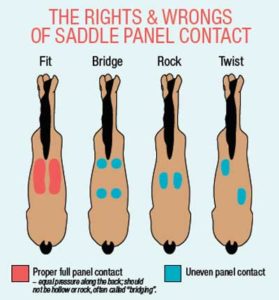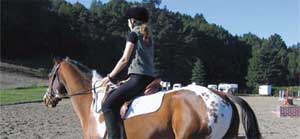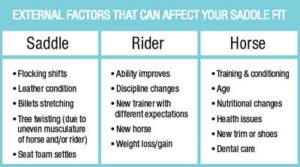Saddle fitting is not rocket science, but it is a learned skill – the ideal combination of art (feel) and science (analysis of measurements) to determine the optimum fit. Since correct saddle fit is such an integral part of the whole horse concept, it’s always best to work with someone who is qualified to ensure that you find the best solution that works for both you and your horse! However, with some basic English saddle fit principles, any rider can conduct an initial evaluation of the equipment they’re using.
 Fit the Horse
Fit the Horse
Believe it or not, there are many more points of reference on the rider to take into consideration than there are for the horse, so we’ll start with the easy part – the horse.
These eight areas of concern can help determine whether your saddle fits your horse. They should be done with the horse standing square on the ground with the saddle girthed up, without pad or rider.
1. Balance: the center of your saddle should be parallel to the floor.
2. Straightness: saddle should not be skewed to one side when viewed from back.
3. Withers clearance: 1-2 fingers all around the muscle at the pommel – not just over the withers!
4. Gullet width: 3-4 fingers so as not to interfere with spinal processes, dorsal ligament system, and nerve endings along the back.
5. Full panel contact: equal pressure along the back; should not be hollow or rock, often called “bridging”.
6. Billet alignment: should hang perpendicular to the ground.
7. Shoulder angle: panel points should be flush with shoulder to not interfere with horse’s freedom of movement.
8. Treepoints behind shoulder blades, not on them! Preferably curved backwards so as not to interfere with movement.
So after you check the above, your saddle seems to fit the horse properly, but something is still not quite right. Now it’s time to ask “Does your saddle fit you?”
Fit the Rider
Although many riders are most concerned about proper saddle fit for their horse, they must also consider themselves. It is important that the saddle feel comfortable and fit the rider correctly, because if it doesn’t, this discomfort will transfer down to the horse, causing pain and imbalance.
These four main keys are important for riders to consider.
1. Saddle seat. Should be large enough to allow you at least one to two fingers of room at the cantle. It’s also important that the seat balance of the saddle feel comfortable for the individual; some are forward, some centre, some are rear balanced.
2. Twist. Ensure that the twist (the part of the tree you feel between your thighs) is correct and comfortable for you – men and women are built differently and this should be reflected in the saddle design.
3. Flap design and length. Needs to be such that your leg is positioned properly with enough leather behind your thigh to ‘cover’ it. Make sure the flap is attached at the correct angle at the back of the saddle bellies so it’s functional as well as visually appealing.
4. Stirrup bars. You may need to extend your stirrup bars if the ratio of your upper leg length to your lower leg length warrants it. This allows your leg to hang properly. Outside influences So now you have an English saddle that fits your and your horse. But wait – of course it’s not that simple in the horse world! There are many external influences that can adversely affect your saddle’s fit from year to year or even from one day to the next. Be aware of some of these factors and always give your horse the benefit of the doubt if he suddenly starts misbehaving. Check your saddle fit!
So is saddle fitting art or science? Optimally, in order to fit the horse and the rider, it’s a combination of both. Because there are so many variables to consider, it’s best to work with someone who is qualified to ensure the best fit. But in the meantime, use the above principles to get a better idea of what you’re dealing with.
Signs your horse may have saddle fit issues:
• Won’t stand for saddling, cinching, mounting
• Bucks, runs away or is hard to catch
• Head tossing or refuses jumps
• Is ‘cold-backed’
• Has dry spots under wet blanket
• Doesn’t travel well downhill or stumbles frequently
• Behavior deteriorates during the course of the ride
•Quits ‘working’ mid-session or mid-season
Signs you might have saddle fit issues:
• Do you hear “get your legs back, put your heels down” as a regular part of your riding lesson?
• Are your shoulders, hips, and heels out of alignment (the classical dressage position)?
• Are your stirrup leathers the same length but feel uneven?
• Do you lean to one side?
• Do you feel twisted in your saddle?
• Do you use more than a thin cotton pad under your saddle to help your position?
• Are you just plain uncomfortable in your saddle and think “there’s gotta be a better way?”








